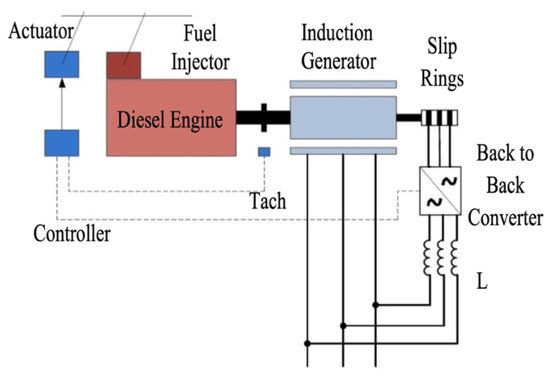
| Version | Summary | Created by | Modification | Content Size | Created at | Operation |
|---|---|---|---|---|---|---|
| 1 | Mohammadjavad Mobarra | + 769 word(s) | 769 | 2022-01-18 04:32:12 | | | |
| 2 | Mohammadjavad Mobarra | + 4626 word(s) | 5395 | 2022-01-18 19:46:15 | | | | |
| 3 | Catherine Yang | -4626 word(s) | 769 | 2022-01-19 02:19:26 | | |
Video Upload Options
Variable Speed Diesel Generators (VSDGs) is a solution to optimize engine consumption and increase system efficiency during different regimes. It improves system behavior by adapting diesel generators (DGs) speed with demanded mechanical load from the generator. VSDG improves efficiency, increases engine lifetime, reduces fuel consumption, and GHG emissions. Conventional fixed speed DG can rarely operate at less than 50% of the maximal load, while VSDGs can operate for a long period at low rotational speed to support lower loads.
1. Electrical Approach to VSDG

2. Mechanical Approach to VSDG
3. Conclusion
Grid power quality, system stability, and production efficiency are three major challenges of every modern power system. Turning to a future energy production perspective, modern DEs operating to meet emergency conditions or, in worse cases, regulating system parameters (voltage, frequency). High penetration of renewable energy sources into hybrid power systems keeps modern DG on-hold for particular operations such as backup or SSM. In such a system, synchronizing variable speed techniques into an electric power grid would be a new challenge. This strategy especially helps the conventional power sources reduce their fuel consumption and minimize additional expenses. Among proposed production systems, some techniques are able to save more fuel and produce more reliable outputs. However, these methods are not suitable for all applications, specifically with sudden and large load oscillations. On the other hand, some techniques demonstrate reliable performance during load variation even in remote areas but not too efficiently for small communities as they need a high initial investment.
References
- Kimura, M.; Koharagi, H.; Imaie, K.; Dodo, S.; Arita, H.; Tsubouchi, K. A permanent magnet synchronous generator with variable speed input for co-generation system. In Proceedings of the 2001 IEEE Power Engineering Society Winter Meeting, Conference Proceedings (Cat. No.01CH37194), Columbus, OH, USA, 28 January–1 February 2001; Volume 3, pp. 1419–1424.
- Wang, D.H.; Nayar, C.V.; Wang, C. Modeling of stand-alone variable speed diesel generator using doubly-fed induction generator. In Proceedings of the the 2nd International Symposium on Power Electronics for Distributed Generation Systems, Hefei, China, 16–18 June 2010; pp. 1–6.
- Lee, J.-H.; Lee, S.-H.; Sul, S.-K. Variable-Speed Engine Generator With Supercapacitor: Isolated Power Generation System and Fuel Efficiency. IEEE Trans. Ind. Appl. 2009, 45, 2130–2135.
- Pena, R.; Clare, J.; Asher, G. A doubly fed induction generator using back-to-back PWM converters supplying an isolated load from a variable speed wind turbine. IEE Proc.-Electr. Power Appl. 1996, 143, 380–387.
- Hamilton, J.; Negnevitsky, M.; Wang, X. The potential of variable speed diesel application in increasing renewable energy source penetration. Energy Procedia 2019, 160, 558–565.
- Issa, M.; Ibrahim, H.; Hosni, H.; Ilinca, A.; Rezkallah, M. Effects of Low Charge and Environmental Conditions on Diesel Generators Operation. Eng 2020, 1, 137–152.
- Issa, M.; Fiset, J.; Ibrahim, H.; Ilinca, A. Eco-Friendly Selection of Diesel Generator Based on Genset-Synchro Technology for Off-Grid Remote Area Application in the North of Quebec. Energy Power Eng. 2019, 11, 232–247.
- Gosala, D.B.; Allen, C.M.; Ramesh, A.K.; Shaver, G.M.; McCarthy, J.; Stretch, D.; Koeberlein, E.; Farrell, L. Cylinder deactivation during dynamic diesel engine operation. Int. J. Engine Res. 2017, 18, 991–1004.
- Iglesias, I.; Garcia-Tabares, L.; Agudo, A.; Cruz, I.; Arribas, L. Design and simulation of a standalone wind-diesel generator with a flywheel energy storage system to supply the required active and reactive power. In Proceedings of the 2000 IEEE 31st Annual Power Electronics Specialists Conference. Conference Proceedings (Cat. No.00CH37018), Galway, Ireland, 23–23 June 2000; Volume 3, pp. 1381–1386.
- Sebastian, R.; Pena-Alzola, R.; Quesada, J. Simulation of a wind diesel power system with flywheel energy storage. In Proceedings of the 2017 IEEE 26th International Symposium on Industrial Electronics (ISIE), Edinburgh, UK, 19–21 June 2017; pp. 2115–2120.
- Singh, M.; Gandhi, S.K.; Mahla, S.K.; Sandhu, S.S. Experimental investigations on performance and emission characteristics of variable speed multi-cylinder compression ignition engine using Diesel/Argemone biodiesel blends. Energy Explor. Exploit. 2017, 36, 535–555.




